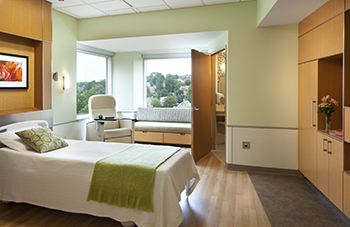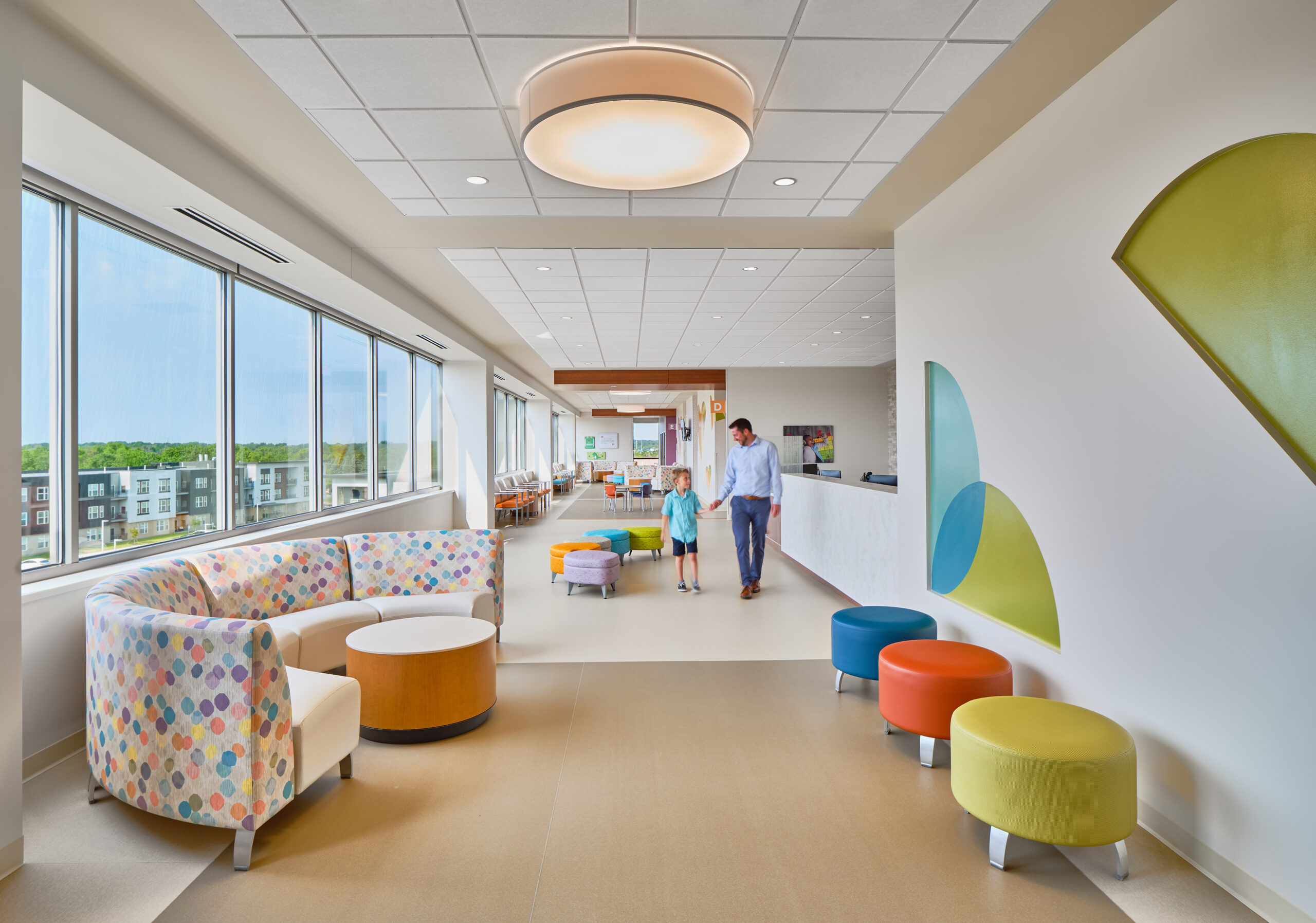 Inpatient units traditionally have been designed around a central hub consisting of a large communal nurses’ station, medication room, supply room and other support rooms. This is where caregivers performed a majority of their tasks and spent a majority of their time.
Inpatient units traditionally have been designed around a central hub consisting of a large communal nurses’ station, medication room, supply room and other support rooms. This is where caregivers performed a majority of their tasks and spent a majority of their time.
Yet this design paradigm is beginning to change as more Americans gain access to health care insurance through the Affordable Care Act, the aging population continues to grow (from 35 million today to 72 million by 2030) and the nursing workforce begins to shrink (50% of nurses are nearing retirement). With caregivers working longer hours and caring for more patients due to these demographic changes, workflow inefficiencies have become more evident in the traditional centralized care model, which often encourages caregivers — nurses in particular — to hunt and gather for medical supplies.
The increasing demand and expectations of nurses has forced health care designers and administrators alike to redesign environments that decrease time spent traveling and increase time spent providing direct patient care. A design solution has been to decentralize caregivers’ tasks and work areas to support a patient-centered care model. Decentralization involves separating highly utilized items that were once found in the central hub (such as charting stations, medications and supplies) and locating them closer to the point-of-care.
Description of the Three Units
To understand if decentralized environments are performing the way they were designed to, HGA Architects and Engineers conducted post-occupancy evaluations at three recently designed inpatient units. Each unit supports a decentralized care delivery model with private patient rooms, yet each varies in configuration and deployment of medication and supplies.
For example, SSM St. Clare Health Center replacement hospital in Fenton, Mo., blends lean design principles with cutting-edge technology to streamline work processes. The 16,200-square-foot single-loaded corridor telemetry unit studied was designed with a decentralized core area where supply rooms and other support areas are located. In addition, there are individual charting stations outside each of the 24 private patient rooms. The patient rooms are also equipped with bedside charting along with medication and supply storage.
At Owatonna Hospital in Owatonna, Minn., the new 10,970-square-foot medical-surgical unit studied supports 18 private patient rooms along a double-loaded corridor design. The unit is configured among two pods. Each pod incorporates a nurses’ station with a charting, medication and nourishment area, a clean holding room, a soiled utility room and nine patient rooms. In addition, the patient rooms have bedside charting and a mobile server to store common medication and medical supplies.
At Butler Memorial Hospital in Butler, Pa., the design team took into account adjacency of medical supplies when designing the seven-floor bed tower addition. The new 21,800-square-foot telemetry unit has a racetrack single-loaded corridor configuration with 26 private patient rooms. In support of a decentralized environment, there are charting stations positioned between a pair of patient rooms and bedside charting and a pass-through server within each patient room.
Research Method
To understand the impact of these decentralized design models on nurses work process and efficiency, HGA Architects and Engineers shadowed day-shift nurses in 30-minute segments. In all, 140 shadows occurred for 70 hours of direct shadowing. During the shadow, researchers kept a log to track the nurses’ path traveled, tasks performed and amount of time spent in areas. The data collected was then analyzed to uncover average time spent in patient rooms, distance traveled and work processes.
The study results demonstrate that nurses on average spent half their day in patient rooms (52 percent). This is a significant increase from the 30.8 percent reported in a previous study that investigated various inpatient unit designs entitled “A 36-Hospital Time and Motion Study” published in The Permanente Journal. Furthermore, nurses spent an average of 6 percent of their day traveling, which equates to roughly 1.43 miles of traveling during an eight-hour shift. This value is notably lower than 2.8 miles reported in an article entitled “How Far Do Nurses Walk?” published in Medsurg Nursing that examined four inpatient units with centralized designs.
These results indicate that adopting a decentralized environment has reduced the need to travel as frequently and as far since commonly used items are positioned closer to the point-of-care. The time saved by traveling less has translated into more time spent in patient rooms.
All three units studied came from a centralized work environment. A concern among caregivers transitioning from a centralized to decentralized work environment is the inability to have spontaneous collaboration and to locate other caregivers quickly for assistance. They feared that separating activities, such as charting, could present a feeling of isolation and that camaraderie would be lost. However, nurses were observed engaging in face-to-face interaction with other caregivers during half of their visits to charting stations. In addition, caregivers on all three units also utilized a wireless phone system, such as Vocera, to help them locate and communicate with others. The findings demonstrate that decentralized environments can still support a collaborative environment and provide opportunities of direct and indirect interaction among caregivers.
The observations revealed that a nurse’s primary path of travel was between charting stations and patient rooms. Therefore, dispersing multiple charting stations among the unit creates for a more efficient workflow environment. However, designers often question how many charting stations are actually required to maintain an efficient workflow and space utilization. As demonstrated with the three units studied, each varying in quantity of charting stations, there are endless possibilities in which a decentralized model can be configured. However, a correlational analysis showed no relationship between the amount of time spent in patient rooms and the number of charting stations on the unit. Therefore, designers should concentrate on customizing charting station decisions based on specific care delivery needs of a particular unit.
Conclusion
Multiple compounding factors, including health care reform, nursing shortage and an aging population has forced the need to create more efficient, patient-centered care environments for caregivers. Designers are responding to these demands by transitioning from a centralized to a decentralized care model. By doing so, nurses are able to spend more time in patient rooms because less time is spent at charting stations and traveling for supplies. Further research needs to be conducted to understand other possible benefits associated to decentralized care, such as reduction in patient falls and lower noise levels.
Kara Freihoefer, PhD, is a design researcher specializing in evidenced-based design, user experience, and human interaction with the built environment with HGA Architects and Engineers.





